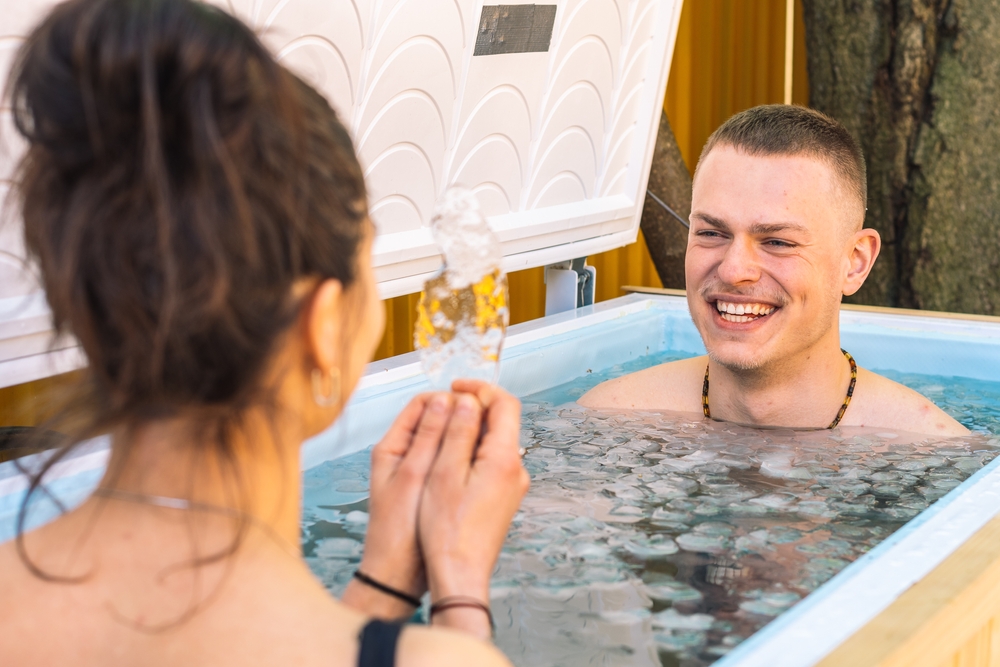Is taking ice baths good for you? Discover the benefits and risks
This content is provided by a third party.
You’ve probably heard of athletes plunging into ice baths after intense workouts, but have you ever wondered if they’re truly beneficial for you? Ice baths, or cold-water immersion, have become a popular recovery technique, promising to reduce muscle soreness and speed up recovery. Yet, as with many wellness trends, it’s essential to separate fact from fiction.
In recent years, the practice has gained traction beyond professional sports, with fitness enthusiasts and wellness seekers alike embracing the chilly plunge. The idea is simple: submerging your body in ice-cold water may constrict blood vessels, reduce inflammation, and flush out metabolic waste. But is this icy ritual truly a miracle cure, or just another fad?
Before you dive into freezing waters, it’s crucial to understand the science behind ice baths and their potential benefits and drawbacks. Let’s explore whether taking the plunge is right for you and how it might fit into your wellness routine.
“We’ve seen firsthand how cold-water immersion can support recovery, but it’s important for people to approach it with a good understanding,” explains Sam from Primal Ice, a pioneer in the ice bath industry in Australia. “Ice baths are highly effective in reducing muscle soreness, enhancing circulation, and speeding up recovery after strenuous activities, but they’re not a one-size-fits-all solution. Each person’s body reacts differently, and factors like immersion time and water temperature make a big difference in the benefits you’ll experience. For most people, keeping the bath between 10°C and 15°C and limiting sessions to 10-15 minutes allows for effective recovery while minimising risks. Always remember, consistency and safety are key.”
Benefits of ice baths
Ice baths offer several advantages for those engaged in regular physical activity. They target key areas such as muscle soreness, recovery time, and circulation, making them a popular choice in recovery routines.
Reducing muscle soreness
Ice baths relieve muscle soreness after intense workouts or competitions. The cold temperature constricts blood vessels, reducing inflammation and limiting the swelling often accompanying strenuous exercise. This phenomenon, known as delayed onset muscle soreness (DOMS), becomes more manageable when incorporating cold-water immersion.
Boosting recovery time
Accelerating recovery time is another compelling reason to consider ice baths. The body’s response to cold immersion helps flush out lactic acid and metabolic waste from muscle tissue. Faster waste removal allows tissues to start the repair process quickly. Enhanced repair processes enable you to resume training with minimal downtime between sessions.
Enhancing circulation
Ice baths contribute to improved circulation, benefiting overall vascular function. The cold stimulus causes your blood vessels to constrict and then expand. This action results in increased blood flow, delivering essential nutrients to muscles. Enhanced nutrient delivery supports tissue healing and reduces fatigue, optimising your body for future exertions.
Potential risks and drawbacks
While ice baths might offer recovery benefits, they also pose certain risks that should be considered.
Risk of hypothermia
Prolonged exposure to cold water can lower your core body temperature significantly. This increases your risk of hypothermia, particularly if the temperature is below 10°C. Limit immersion to 10-15 minutes to reduce this risk.
Skin damage concerns
Extended contact with ice can damage your skin, potentially leading to frostbite. Areas most vulnerable include toes, fingers, and ears. Always monitor for numbness or discolouration to prevent damage.
Impact on heart health
Cold exposure causes blood vessels to constrict, which might elevate blood pressure. If you have heart conditions or hypertension, consult with a healthcare professional before using ice baths to avoid cardiovascular strain.
Scientific research and evidence
Research on ice baths, also known as cold-water immersion, reveals both supportive and sceptical perspectives. Understanding these can help you make informed decisions.
Studies supporting ice bath benefits
Several studies suggest that ice baths can enhance recovery. In 2013, a study in the Journal of Strength and Conditioning Research showed that athletes who used ice baths reported less muscle soreness 24 hours after exercise compared to those who did not. Another 2017 study in the Journal of Sports Medicine and Physical Fitness found that regular cold-water immersion reduced muscle inflammation, promoting quicker recovery. These findings bolster the notion that controlled cold exposure aids recovery by affecting muscle soreness and inflammation.
Criticisms and skepticism
Despite these positive findings, some research remains sceptical. A meta-analysis in the International Journal of Epidemiology in 2016 found that while some individuals experienced benefits, the overall effect on muscle recovery was minimal. Critics also point out that placebo effects might account for perceived benefits, as highlighted by a 2015 study in the British Journal of Sports Medicine. Thus, while some support exists, further research is necessary to conclusively determine ice baths’ effectiveness in recovery scenarios.
Best practices for taking ice baths
Incorporating ice baths into your recovery regimen requires attention to duration, temperature, and safety measures. Following best practices ensures you maximise benefits while minimising risks.
Optimal duration and temperature
Maintain a balance with time and temperature to gain the most from ice baths. Aim for a temperature between 10°C and 15°C. This range effectively constricts blood vessels without risking hypothermia or frostbite. Limit immersion to 10-15 minutes, as prolonged exposure can cause harm. These parameters provide effective recovery without compromising your health.
Safety precautions to consider
Safety during ice baths involves monitoring both physical and environmental factors. Before starting, consult a healthcare professional if you have heart issues or hypertension. During the bath, watch for numbness or discolouration in extremities such as toes or fingers, as these indicate potential frostbite. Use ice baths in controlled environments to avoid cold-related accidents. Ensure that help is available if you begin to feel unwell or disoriented. These precautions help prevent adverse effects and ensure a safe experience.
Conclusion
Deciding whether to incorporate ice baths into your recovery routine requires careful consideration of both their benefits and potential risks. While they may offer relief from muscle soreness and speed up recovery, it’s vital to weigh these advantages against possible drawbacks like hypothermia or skin damage. Always adhere to recommended guidelines on temperature and duration to maximise benefits safely. Consulting a healthcare professional is wise, especially if you have underlying health conditions. As research continues to evolve, stay informed and make choices that best suit your individual needs and circumstances.
Frequently asked questions
What are the primary benefits of ice baths?
Ice baths help reduce muscle soreness, speed up recovery, constrict blood vessels, and flush out metabolic waste. By immersing in cold water, athletes may experience relief from muscle soreness, accelerated recovery by clearing lactic acid, and enhanced circulation due to the constriction and subsequent expansion of blood vessels.
How long should one stay in an ice bath?
For optimal benefits and to minimise risks such as hypothermia, it’s recommended to limit ice bath sessions to 10-15 minutes. The water temperature should be maintained between 10°C and 15°C to ensure safety and effectiveness.
Are there any risks associated with ice baths?
Yes, potential risks include hypothermia, frostbite, and elevated blood pressure. Prolonged exposure can lead to cold-related injuries, especially in temperatures below 10°C. Those with heart conditions or hypertension should consult a healthcare professional before using ice baths.
Is scientific research supportive of ice baths for recovery?
Research shows mixed results. Some studies highlight reduced muscle soreness and inflammation, while others find minimal overall recovery benefits. A 2016 meta-analysis suggests the possibility of placebo effects. More research is needed for conclusive evidence.
Can everyone use ice baths safely?
Not everyone should use ice baths without precautions. Individuals with heart conditions, hypertension, or those vulnerable to cold injuries should seek medical advice. Monitoring for signs of frostbite and ensuring proper duration and temperatures can enhance safety.
What safety measures should be taken during ice baths?
Ensure the temperature is between 10°C and 15°C and limit immersion to 10-15 minutes. Monitor for numbness or discolouration as signs of frostbite and seek medical advice if you have any heart conditions or circulation issues before starting ice baths.
This information is of a general nature only and should not be regarded as specific to any particular situation. Readers are encouraged to speak with their GP and seek appropriate medical advice based on their personal circumstances.
This is content submitted by a third party. It does not necessarily represent the views of the publisher of this website.



















